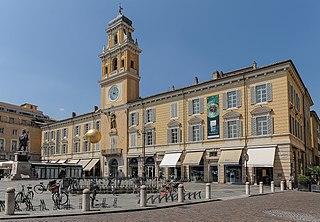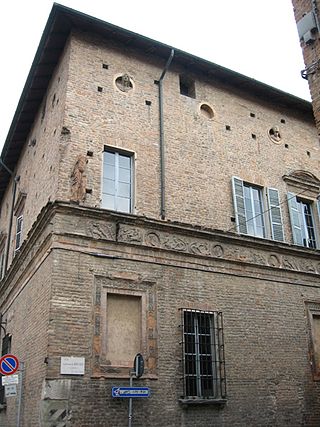
Parma is a city in the northern Italian region of Emilia-Romagna known for its architecture, music, art, prosciutto (ham), cheese and surrounding countryside. With a population of 198,292 inhabitants, Parma is the second most populous city in Emilia-Romagna after Bologna, the region's capital. The city is home to the University of Parma, one of the oldest universities in the world. Parma is divided into two parts by the stream of the same name. The district on the west side of the river is Oltretorrente. Parma's Etruscan name was adapted by Romans to describe the round shield called Parma.

Piacenza is a city and comune (municipality) in the Emilia-Romagna region of Northern Italy, and the capital of the eponymous province. As of 2022, Piacenza is the ninth largest city in the region by population, with more than 102,000 inhabitants.

The Duchy of Parma and Piacenza was an Italian state created in 1545 and located in northern Italy, in the current region of Emilia-Romagna.

Francesco Mochi was an Italian early-Baroque sculptor active mostly in Rome, Piacenza and Orvieto. His dramatic early works in Orvieto are now often regarded as the first truly Baroque sculptures.

Palazzo Farnese is a palace in Piacenza, northern Italy.

The Shrine of Santa Maria della Steccata is a Greek-cross design Renaissance church in central Parma, Italy. The name derives from the fence in the church. A Nursing Madonna is enshrined within, crowned on 27 May 1601 by a Marian devotee, Fray Giacomo di Forli of the Capuchin order. Pope Benedict XVI raised the Marian sanctuary to the status of Basilica minor on 9 February 2008.

San Francesco is a Roman Catholic church, located on Piazza Cavalli #68 in Piacenza, Italy. It was built in a style described as Lombard Gothic and is centrally located facing towards the Piazza del Cavalli, which is surrounded by the Palazzo Gotico and the Palazzo del Governatore.
San Pietro is a Roman Catholic church in central Piacenza, Emilia Romagna, Italy. The church was built over the site of an ancient church titled San Pietro in Foro.

Sant'Agostino is a Renaissance style, former Roman Catholic church, located at the intersection of the Avenue Farnese and via Giordani in Piacenza, region of Emilia Romagna, Italy.

The Gazzola Institute is a school of the arts and art museum, located on via Gazzola n°9 in the town of Piacenza, region of Emilia Romagna, Italy.

The Palazzo della Prefettura also called the Palazzo Scotti di Vigoleno is a Baroque architecture-style palace located on Via San Giovanni #17 in central Piacenza, region of Emilia-Romagna in Italy. The palace houses the offices of the provincial administration.

Palazzo Comunale is a Gothic style palace located facing Piazza del Cavalli in the historic center of Piacenza, northern Italy which now serves as the seat of municipal administration. The facade is flanked by two bronze equestrian statues sculpted by Francesco Mochi and depicting the Farnese Dukes of Parma: Ranuccio (1612–20) and his father, Alexander (1620-1629). Across the piazza is the late-Baroque or early neoclassic Palazzo del Governatore (1787) designed by Lotario Tomba. Recessed and to the right is the 17th-century Collegio dei Mercanti.

The Palazzo del Giardino or Palazzo Ducale del Giardino is a historic palace in the Parco Ducale in Parma. It is not to be confused with the official Parma residence of Marie Louise, Duchess of Parma between Palazzo della Pilotta and Palazzo della Provincia in what is now known as piazzale della Pace - she also lived at the Ducal Palace of Colorno and in the Casino dei Boschi in Sala Baganza. The main Ducal Palace in Parma, the Palazzo della Pilotta and the Reinach Theater were all destroyed in an early morning air raid on 13 May 1944, carried out by the 465th Heavy Bombardment Group of the US Airforce, 781st Squadron, which dropped 9 GP bombs on the city centre.

Simone Moschino was an Italian Renaissance sculptor and architect, born in Orvieto as Simone Simoncelli.

The Ducal Palace of Parma was a neoclassical palace in Parma, Italy. It was located on the west side of the Piazzale della Pace. Between its construction and 1859, it was the residence of the Dukes of Parma. After 1859, it became the prefecture.

The Palazzo del Collegio dei Mercanti is a baroque-style palace located recessed and to the left of the Palazzo Gotico facing Piazza dei Cavalli in the historic center of Piacenza, northern Italy. It now houses the offices of the town hall and council.

San Vincenzo is a Baroque style, Roman Catholic church, now deconsecrated, located at Via Scalabrini #6 in the South-East quadrant of Piacenza, Region of Emilia Romagna, Italy. The church was restored starting in 2009 for use as an auditorium and to host concerts.

Piazza dei Cavalli is one of the oldest and main public squares in the historic center of the city of Piacenza, Italy. Once called Piazza Grande, it competes with the Piazza del Duomo, located some 4 blocks southeast for prominence. This square, unlike the latter, is mainly ringed by secular buildings relating to the political and business community.

The Palazzo Landi is a Renaissance-style palace located on Via dei Consiglio #15 in the historic center of Piacenza, northern Italy.



















